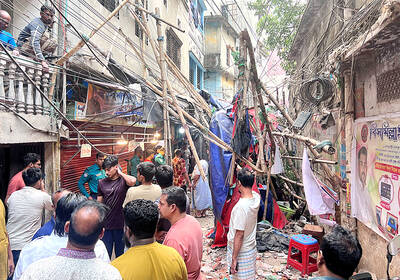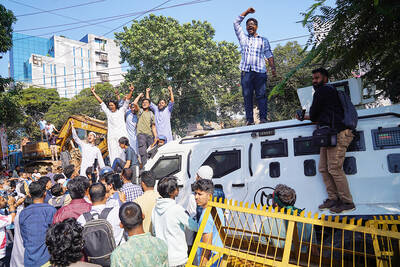It was a terrible coincidence that has focused attention on one of Vietnam's worst problems: In the past week, motorbikes hit and killed two beloved professors on the streets of Hanoi.
One, the president of Hanoi National University, died a day after he was struck during an afternoon stroll near his home.
The other, a professor emeritus from the Massachusetts Institute of Technology in the US, is in a coma after being run down on a busy street in front of his Hanoi hotel.
A chartered plane yesterday flew technology and education expert Seymour Papert, 78, back to Boston, along with family members, a nurse and a neurologist.
Papert, in Hanoi for an international mathematics conference, had been talking to a friend about ways to solve Hanoi's traffic problems when a speeding motorbike hit him on Dec. 7.
On Thursday, thousands attended the funeral of university president and mechanical engineering professor Nguyen Van Dao, 70.
"We must find a way to solve the traffic problems here," said Nguyen Thi Viet Thanh, a colleague of Dao's. "This is such a big loss."
Government statistics show traffic accidents, the leading cause of death in Vietnam, claim about 12,000 lives every year in the country of 84 million.
Some international organizations estimate the actual number is twice as high.
Ninety percent of accidents involve motorbikes, the primary means of transport in the developing country, where few can afford cars.
Hanoi and Ho Chi Minh City roads teem with speeding motorbikes. Traffic law enforcement is lax. Drivers routinely run red lights and go the wrong way on one-way streets.
Honking horns and chatting on mobile phones, they weave across lane markers.
Crossing the street is hazardous for pedestrians, especially tourists unfamiliar with local driving habits.
"The number of deaths is shocking, but the number of injuries is three times as high," said Nguyen Phuong Nam of the WHO's Vietnam office. "There are many serious head injuries."
Very few motorcyclists use helmets and many drivers lack experience, said Greig Craft, president of the Asia Injury Prevention Fund, a nonprofit group that makes low-cost helmets and promotes safe driving.
"I would call the traffic situation here an absolute crisis," Craft said. "In the West, if you run a red light, it is culturally unacceptable. But here, the young Vietnamese think it's cool."
Craft's group has been working for years to persuade Vietnam to make helmets mandatory, which he says would immediately cut traffic deaths by more than 30 percent.
Most Vietnamese believe strongly in fate, and that death will come when it is meant to. This contributes to a fatalistic attitude about traffic safety.
But the two professors' recent deaths have prompted many Vietnamese to call for a safety campaign. Newspapers have been filled with stories about the accidents. People flooded Internet chatrooms to vent frustrations.

DISASTER: The Bangladesh Meteorological Department recorded a magnitude 5.7 and tremors reached as far as Kolkata, India, more than 300km away from the epicenter A powerful earthquake struck Bangladesh yesterday outside the crowded capital, Dhaka, killing at least five people and injuring about a hundred, the government said. The magnitude 5.5 quake struck at 10:38am near Narsingdi, Bangladesh, about 33km from Dhaka, the US Geological Survey (USGS) said. The earthquake sparked fear and chaos with many in the Muslim-majority nation of 170 million people at home on their day off. AFP reporters in Dhaka said they saw people weeping in the streets while others appeared shocked. Bangladesh Interim Leader Muhammad Yunus expressed his “deep shock and sorrow over the news of casualties in various districts.” At least five people,

The latest batch from convicted sex offender Jeffrey Epstein’s e-mails illustrates the extraordinary scope of his contacts with powerful people, ranging from a top Trump adviser to Britain’s ex-prince Andrew. The US House of Representatives is expected to vote this week on trying to force release of evidence gathered on Epstein by law enforcement over the years — including the identities of the men suspected of participating in his alleged sex trafficking ring. However, a slew of e-mails released this week have already opened new windows to the extent of Epstein’s network. These include multiple references to US President Donald

LEFT AND RIGHT: Battling anti-incumbent, anticommunist sentiment, Jeanette Jara had a precarious lead over far-right Jose Antonio Kast as they look to the Dec. 14 run Leftist candidate Jeannette Jara and far-right leader Jose Antonio Kast are to go head-to-head in Chile’s presidential runoff after topping Sunday’s first round of voting in an election dominated by fears of violent crime. With 99 percent of the results counted, Jara, a 51-year-old communist running on behalf of an eight-party coalition, won 26.85 percent, compared with 23.93 percent for Kast, the Servel electoral service said. The election was dominated by deep concern over a surge in murders, kidnappings and extortion widely blamed on foreign crime gangs. Kast, 59, has vowed to build walls, fences and trenches along Chile’s border with Bolivia to

DEATH SENTENCE: The ousted leader said she was willing to attend a fresh trial outside Bangladesh where the ruling would not be a ‘foregone conclusion’ Bangladesh’s fugitive former prime minister Sheikh Hasina yesterday called the guilty verdict and death sentence in her crimes against humanity trial “biased and politically motivated.” Hasina, 78, defied court orders that she return from India to attend her trial about whether she ordered a deadly crackdown against the student-led uprising that ousted her. She was found guilty and sentenced to death earlier yesterday. “The verdicts announced against me have been made by a rigged tribunal established and presided over by an unelected government with no democratic mandate,” Hasina said in a statement issued from hiding in India. “They are biased and politically motivated,” she